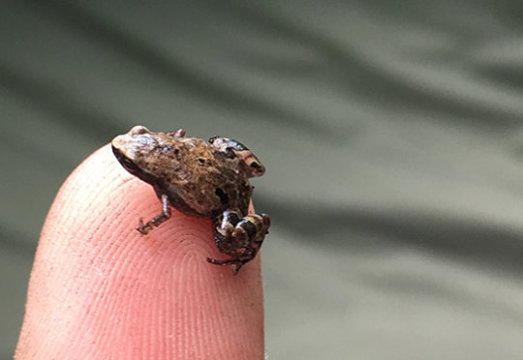[ad_1]
Scientists at Ludwig-Maximilians-Universitaet (LMU) in Munich and the Bavarian State Collection of Zoology have named five new species of frogs found across the island of Madagascar. The largest could sit on your thumbnail, the smallest is hardly longer than a grain of rice.
Madagascar, an island a little larger than mainland France, has more than 350 frog species. This number of recognized species is constantly rising, and many of the newly named species are very small.
Mark D. Scherz, a PhD candidate at LMU Munich, and Dr. Frank Glaw, Head of the Herpetology Section at the Bavarian State Collection of Zoology in Munich, together with colleagues at the Technical University of Braunschweig and the University of Antananarivo have named five new species of tiny frogs found across the island. Their study appears in the online journal PLOS ONE.
The five new species belong to a group of frogs commonly referred to as ‘narrow-mouthed’ frogs, a highly diverse family found on every continent except Antarctica and Europe. Although most narrow-mouthed frogs are small to moderately large, many are tiny. In fact, the group includes the smallest frog in the world — Paedophryne amauensis from Papua New Guinea, mature specimens of which reach a length of only 7.7 mm. What’s remarkable is that, in the smallest frogs, “miniaturization” has evolved independently — often several times within a single region, as highlighted in this new study. Three of the new species belong to a group that is wholly new to science, which the authors have formally dubbed Mini. The other two new species, Rhombophryne proportionalis and Anodonthyla eximia, are also just 11-12 mm long, and are much smaller than their closest relatives.
“When frogs evolve small body size, they start to look remarkably similar, so it is easy to underestimate how diverse they really are,” says Mark D. Scherz, lead author on the new study. “Our new genus name, Mini, says it all. Adults of the two smallest species Mini mum and Mini scule are 8-11 mm long, and even the largest member of the genus, Miniature, at 15 mm, could sit on your thumbnail with room to spare.”
Finding tiny frogs in the leaf litter is hard work. “Calling males often sit one or two leaves deep and stop calling at the slightest disturbance,” says Frank Glaw. “It can take a lot of patience to find the frog you are looking for.”
Story Source:
Materials provided by Ludwig-Maximilians-Universität München. Note: Content may be edited for style and length.
[ad_2]















